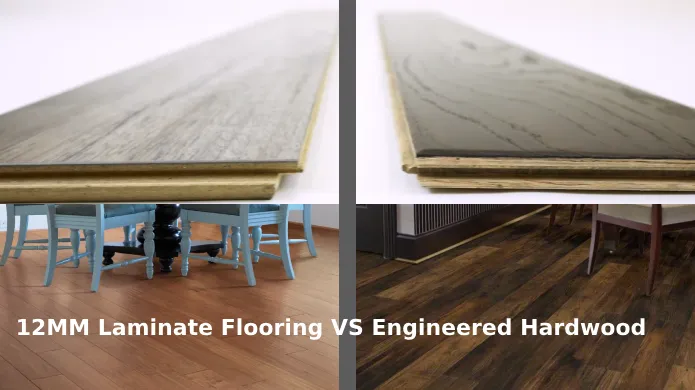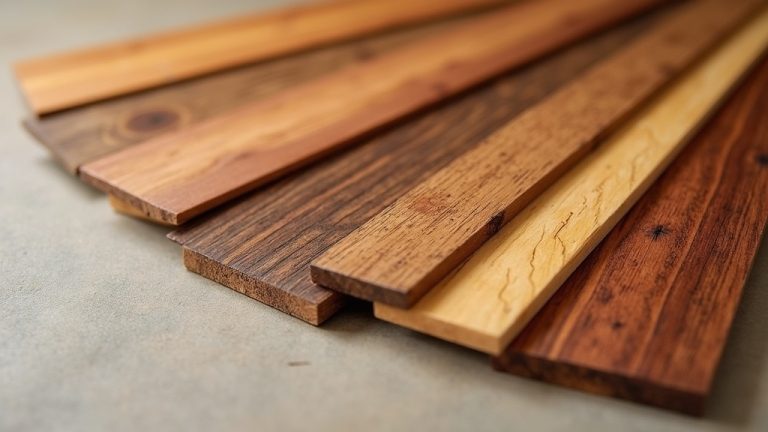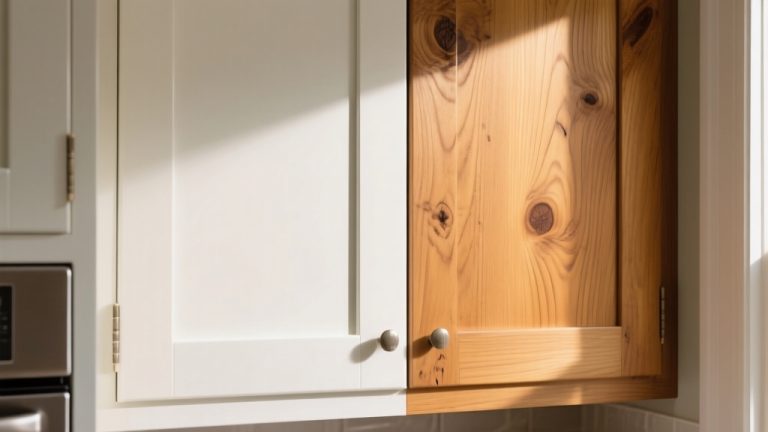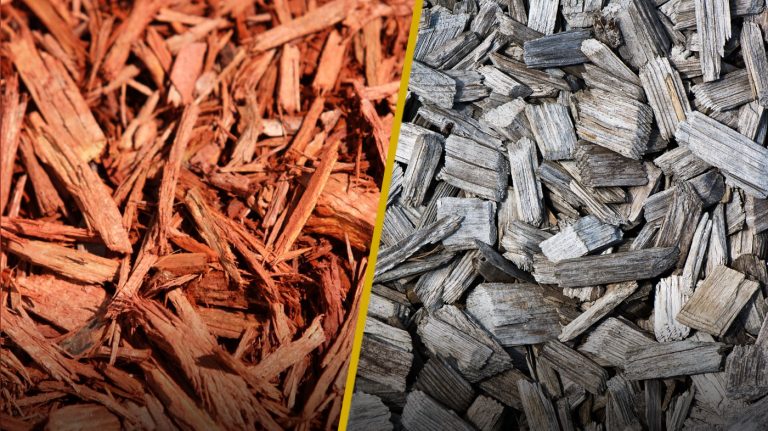12MM Laminate Flooring vs Engineered Hardwood: Significant Differences
When choosing the right type of flooring for your home or office, the options can seem endless, but two popular choices are 12mm laminate flooring and engineered hardwood. Although both have their advantages, there are some significant differences between them.
Laminate flooring is more cost-effective and easier to install but lacks engineered hardwood’s authenticity and natural grain patterns. While engineered hardwood is the more prestigious and higher-quality choice, it can be more expensive and requires professional installation.
Today, we will explore the differences between 12MM laminate flooring and engineered hardwood. We will examine their construction, appearance, water resistance, and environmental impact. So keep reading for more information.
12MM Laminate Flooring vs Engineered Hardwood: Key Differences Explored
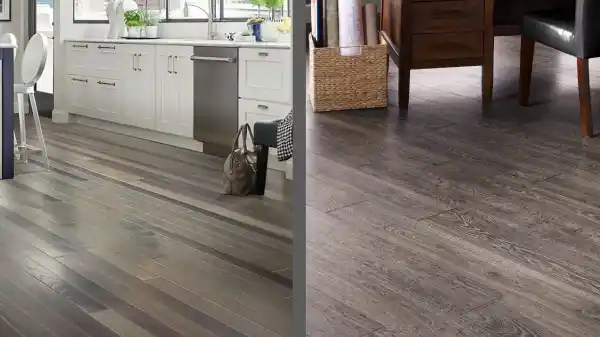
If you’re considering flooring options, you should understand the differences between MM laminate flooring and engineered hardwood.
- Construction and Composition:
- Appearance and Authenticity:
- Ease of Installation:.
- Water Resistance:
- Repair and Refinishing:
- Cost and Value:
- Lifespan:
- Comfort and Noise:
- Resale Value and Prestige:
- Cleaning and Maintenance:
- Environmental Impact:
1. Construction and Composition:
Compared to 12mm laminate flooring, engineered hardwood features a genuine wood veneer bonded to high-quality plywood, resulting in a more durable and long-lasting flooring option.
The construction and composition of engineered hardwood make it a superior choice for homeowners who want the look and feel of real wood without sacrificing durability.
In contrast, laminate flooring is fiberboard with a photographic image layer. While it can mimic the look of hardwood, it lacks the natural beauty and texture of authentic wood.
Also, engineered hardwood is more durable than laminate flooring, as it can be easily scratched or damaged. The following table provides a comparison of the construction and composition of mm laminate flooring and engineered hardwood:
| Laminate Flooring | Engineered Hardwood | |
| Core Material | Fiberboard | High-quality plywood |
| Top Layer | Photographic image layer | Genuine wood veneer |
| Durability | Less durable than engineered hardwood | Can last up to 30 years with proper maintenance |
| Appearance | Mimics the look of hardwood | Authentic wood look and texture |
2. Appearance and Authenticity:
Experience the warmth and charm of genuine wood with the authentic look and feel of engineered hardwood flooring.
Unlike laminate flooring, engineered hardwood is made of real wood, providing a more natural and authentic appearance. The top layer of engineered hardwood is composed of solid wood, which gives it the same texture and feel as solid hardwood flooring.
This layer can be made from various wood species, allowing for various natural grain patterns and colors. In addition to the natural look and feel, engineered hardwood offers a level of durability that laminate flooring cannot match.
The top layer of solid wood is protected by multiple layers of high-quality finishes, making it resistant to scratches, dents, and wear. This means that your engineered hardwood flooring will maintain its beautiful appearance for years, even in high-traffic areas of your home.
3. Ease of Installation:
Installing engineered hardwood is a breeze thanks to its convenient click-lock system, making it an easy DIY project for homeowners.
This type of flooring comes in planks that snap together, eliminating the need for nails or adhesives. You simply lay the planks down and click them into place, creating a seamless and beautiful finished product.
12mm laminate flooring also features a click-lock system, making it an easy DIY option. The planks snap together easily, allowing you to lay down your new floor quickly. However, it’s important to note that laminate flooring can be more susceptible to damage during installation due to its thinner construction.
4. Water Resistance:
You need to be careful about exposing your new floors to water, as both 12mm laminate flooring and engineered hardwood have their limitations regarding water resistance.
While the surface layer of laminate flooring is water-resistant, the core can still be damaged by prolonged exposure to water. This means that spills should be cleaned up immediately to avoid any potential damage.
Also, if you plan on installing laminate flooring in areas prone to moisture, such as bathrooms or kitchens, you may want to consider a waterproof underlayment for added protection.
Conversely, engineered hardwood can also be susceptible to water damage. While the top layer is typically finished with a water-resistant coating, the core can still swell and warp when exposed to water. This means that spills should also be cleaned up immediately to avoid any potential damage.
Also, if you plan on installing engineered hardwood in areas prone to moisture, such as bathrooms or kitchens, you may consider a protective sealant to help prevent damage.
5. Repair and Refinishing:

Fortunately, if you ever need to repair or refinish your floors, options are available to help restore their appearance and durability.
Regarding laminate flooring, damaged planks cannot be refinished and must be replaced. This can be time-consuming and expensive, especially if you have a large area of damaged flooring.
In contrast, engineered hardwood can be sanded and refinished multiple times, making it a more durable and long-lasting option. If you opt for engineered hardwood, you can expect the following benefits to repair and refinishing:
- Easy repair: If you have a small area of damage, such as a scratch or dent, it can be easily repaired by sanding and refinishing the affected area.
- Multiple refinishing options: Depending on the thickness of the top layer, engineered hardwood can be sanded and refinished multiple times over its lifespan.
- Increased durability: Regular refinishing can help to maintain the appearance and durability of your engineered hardwood floors, making them a long-lasting investment for your home.
6. Cost and Value:
Laminate flooring is more cost-effective than engineered hardwood. It can start at just $0.79 to $3.00 per sq. ft per sq ft, while engineered hardwood costs $6 to $20 per square foot plus professional installation.
While engineered hardwood may have a higher upfront cost, it can add more value to your home in the long run. Engineered hardwood is made from real wood, giving it a natural, luxurious look that laminate flooring cannot replicate.
Also, because of its durability and ability to be refinished, engineered hardwood can last for decades, making it a worthwhile investment for homeowners who want to add value to their property.
7. Lifespan:
Get ready to enjoy your floors for years to come because when it comes to lifespan, engineered hardwood outlasts laminate flooring. With proper care and maintenance, engineered hardwood can last 30 years or more, while laminate flooring typically lasts only 10 to 20 years.
So if you’re looking for a long-lasting investment in your home’s flooring, engineered hardwood is the way to go. While it may come at a higher cost upfront, its durability and longevity make it a worthwhile investment in the long run.
8. Comfort and Noise:
You’ll feel the difference under your feet between laminate and engineered hardwood, as the latter is harder and more solid but can also produce less noise.
Laminate flooring, being made of composite wood pressed together, may flex and produce noise when walked on. This can cause concern for those who prefer a quieter environment.
In contrast, engineered hardwood is made of real wood layers, making it feel more solid and sturdy underfoot. The lack of flex in engineered hardwood results in a quieter flooring experience, which can be particularly beneficial for those living in apartments or condos.
To better illustrate the comfort and noise differences between laminate and engineered hardwood, the following table provides a quick comparison:
| Flooring Type | Comfort | Noise |
| Laminate | May flex underfoot | May produce noise when walked on |
| Engineered Hardwood | Feels harder and more solid | Produces less noise when walked on |
9. Resale Value and Prestige:
If you want to impress potential buyers and increase your home’s value, nothing beats the luxurious feel and timeless beauty of engineered hardwood.
Unlike laminate flooring, engineered hardwood is made of real wood and can be sanded and refinished multiple times, which makes it more durable and long-lasting.
This type of flooring is perceived as higher quality and adds a touch of elegance to any home. It also comes in a wide range of colors, finishes, and styles, which gives you the flexibility to choose the perfect match for your décor.
In terms of resale value, engineered hardwood is a smart investment because it can increase the perceived value of your home. According to a study by the National Wood Flooring Association, homes with hardwood flooring sell faster and for higher prices than homes without.
10. Cleaning and Maintenance:
Laminate flooring is easy to clean and maintain. Its moisture-resistant properties make it an ideal choice for high-traffic areas such as the kitchen or bathroom. You can simply sweep or vacuum the laminate flooring to remove dirt and debris, followed by a damp mop using a mild cleaning solution.
Alternatively, engineered hardwood requires more careful cleaning and prompt spill cleanup. Unlike laminate flooring, it’s not moisture-resistant and can be damaged by water. This means that spills must be wiped up immediately to prevent damage to the flooring.
11. Environmental Impact:
When choosing between laminate flooring and engineered hardwood, consider the environmental impact. While both options have benefits, laminate flooring is generally considered more eco-friendly due to its use of recycled materials.
As an alternative, engineered hardwood requires the harvesting of hardwood trees, which can have a significant impact on the environment. Laminate flooring is often made from recycled materials, such as wood chips and sawdust. This means that it helps to reduce waste and minimize the use of new resources.
Is 12mm laminate too thick for flooring?

Contrary to popular belief, 12mm laminate flooring isn’t too thick for use as flooring. In fact, it provides added durability and stability compared to thinner options.
The thickness of the laminate contributes to its strength, making it more resistant to wear and tear. This means it can withstand the daily wear and tear of heavy foot traffic better than thinner laminate options.
Moreover, 12mm laminate flooring provides better soundproofing and insulation properties, making it an ideal choice for apartments or multi-story buildings. It also offers a more substantial feel underfoot, which some homeowners prefer.
Does 12mm laminate need underlay?
If you want to extend the lifespan of your 12mm laminate, it’s recommended to use an underlay. Here are three reasons:
- Protection: An underlay acts as a protective layer between your laminate flooring and the subfloor. It prevents moisture from seeping through, reducing the risk of damage and warping.
- Soundproofing: If you live in an apartment or have rooms above or below each other, you’ll appreciate the soundproofing benefits of an underlay. It minimizes the sound of footsteps, voices, and other noises, creating a quieter and more peaceful environment.
- Insulation: An underlay provides thermal insulation, which helps keep your home warm in the winter and cool in the summer. It reduces heat loss through the subfloor, creating a more energy-efficient home and lower electricity bills.
What thickness underlay for 12mm laminate?
For optimal comfort and protection, you’ll choose an underlay at least 3mm thick when installing 12mm laminate, ensuring a cozy and durable flooring solution for your home. With the right underlay, you can enjoy ground-leveling properties that make your flooring look even and smooth.
However, remember that the underlay should not exceed 5 mm in thickness, as this can cause problems with the stability and durability of the flooring.
What happens if you install laminate flooring without underlayment?
Laminate flooring manufacturers typically recommend an underlayment for a reason. Without it, moisture from the subfloor can seep through and cause your laminate flooring to warp and develop mildew. This can lead to costly repairs and replacements down the line.
In addition to the potential moisture damage, without an underlayment, footsteps on your laminate flooring can be quite loud. The padding helps to absorb some of the sounds, making your floors quieter and more comfortable to walk on.
Do I need a moisture barrier for laminate flooring?
When installing laminate floors, it’s crucial to have a moisture barrier underlayment to protect against potential damage. Moisture can seep through the subfloor or concrete and damage the laminate flooring. This can cause the planks to warp, buckle or even break apart.
A moisture barrier underlayment prevents this by acting as a shield between the laminate and the subfloor. If you ignore this step, you might end up with costly repairs.
Moisture can also promote the growth of mold and mildew, which can cause health problems for you and your family. A moisture barrier underlayment provides an extra layer of protection against these harmful substances.
What is the best thickness for engineered wood flooring?

The optimal thickness for engineered hardwood is typically between 3/4 and 5/8 of an inch, with a wear layer measuring around 3/16 of an inch. This thickness provides the necessary stability for the flooring to withstand foot traffic and other forms of wear and tear.
Also, thicker engineered hardwood can be refinished multiple times, making it more durable and long-lasting. When choosing the thickness of your engineered hardwood flooring, consider the following factors:
- The subfloor: If you have a concrete subfloor, thicker engineered hardwood may be necessary to prevent cracking and shifting.
- The room: High-traffic areas, such as entryways and living rooms, may require a thicker flooring to withstand wear and tear.
- Budget: While thicker engineered hardwood may be more expensive, it’s a worthwhile investment in the long run as it can be refinished multiple times.
Which is better, laminate or engineered hardwood?
If you want a floor covering that’s easier to clean but still looks like real wood, engineered hardwood may be the way to go, whereas laminate flooring may be more budget-friendly.
Engineered hardwood comprises layers of wood veneer that are glued together, with a top layer of solid hardwood. This construction makes engineered hardwood more resistant to moisture and temperature changes than solid hardwood, making it a better choice for bathrooms and basements.
In contrast, laminate flooring comprises layers of fiberboard and a photographic layer that mimics the look of wood. While it may not have the same durability as engineered hardwood, it is still a great choice for those on a budget or who want a DIY option.
Laminate flooring is easy to install, with interlocking planks that can be snapped together without needing nails or glue.
12mm Laminate or Hardwood Flooring: Choose the Best One for Your Home
So, which is better for your home, 12mm laminate flooring or engineered hardwood? The answer largely depends on your personal preferences and needs.
If you’re looking for a budget-friendly option that’s easy to install and maintain, 12mm laminate flooring may be the way to go. It’s durable, scratch-resistant, and comes in various styles and colors. Plus, it’s easy to clean and can be installed over existing flooring.
However, engineered hardwood is a great option if you want to invest more for a higher-quality, natural look. It’s made from real wood, giving it a unique texture and looks that laminate flooring can’t replicate. It also adds value to your home and can be sanded and refinished.
The decision between 12mm laminate flooring and engineered hardwood comes down to your preferences, budget, and needs. Both options have advantages and disadvantages, so weigh them carefully before deciding.

